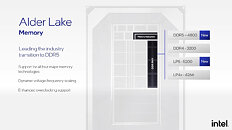- Joined
- Oct 9, 2007
- Messages
- 47,301 (7.52/day)
- Location
- Hyderabad, India
| System Name | RBMK-1000 |
|---|---|
| Processor | AMD Ryzen 7 5700G |
| Motherboard | ASUS ROG Strix B450-E Gaming |
| Cooling | DeepCool Gammax L240 V2 |
| Memory | 2x 8GB G.Skill Sniper X |
| Video Card(s) | Palit GeForce RTX 2080 SUPER GameRock |
| Storage | Western Digital Black NVMe 512GB |
| Display(s) | BenQ 1440p 60 Hz 27-inch |
| Case | Corsair Carbide 100R |
| Audio Device(s) | ASUS SupremeFX S1220A |
| Power Supply | Cooler Master MWE Gold 650W |
| Mouse | ASUS ROG Strix Impact |
| Keyboard | Gamdias Hermes E2 |
| Software | Windows 11 Pro |
Intel will beat AMD to next-generation I/O, with its 12th Generation Core "Alder Lake-S" desktop processors. The company confirmed that the processor will debut both DDR5 memory and PCI-Express Gen 5.0, which double data-rates over current-gen DDR4 and PCI-Express Gen 4, respectively. "Alder Lake-S" features a dual-channel DDR5 memory interface, with data-rates specced to DDR5-4800 MHz, more with overclocking, reaching enthusiast-grade memory attaining speeds in excess of DDR5-7200. Besides speed, DDR5 is expected to herald a doubling in density, with 16 GB single-rank modules becoming a common density-class, 32 GB single-rank being possible in premium modules; and 64 GB dual-rank modules being possible soon. Leading memory manufacturers have started announcing their first DDR5 products in preparation of "Alder Lake-S" launch in Q4-2021.
The memory controller is now able to dynamically adjust memory frequency and voltage, depending on current workload, power budget and other inputs—a first for the PC! This could even mean automatic "Turbo" overclocking for memory. Intel also mentioned "Enhanced Overclocking Support" but didn't go into further detail what that entails. While DDR5 is definitely the cool new kid on the block, Intel's Alder Lake memory controller keeps support for DDR4, and LPDDR4, while adding LPDDR5-5200 support (important for mobile devices). Just to clarify, there won't be one die support DDR5, and another for DDR4, no, all dies will have support for all four of these memory standards. How that will work out for motherboard designs is unknown at this point.




PCI-Express Gen 5.0 is the other big I/O feature. With a bandwidth of 32 Gbps per lane, double that of PCIe Gen 4, the new PCIe Gen 5 will enable a new breed of NVMe SSDs with sequential transfer rates well above 10 GB/s. The desktop dies will feature x16 PCIe Gen 5, and x4 PCIe Gen 4. The PCIe 5.0 x16 can be split into an x8 (for graphics) and 2x x4 (for storage), but it's not possible to run a PCIe 5.0 x16 graphics card at the same time as a PCIe 5.0 SSD. The PCH features up to 12 downstream PCIe Gen4 lanes, and 16 PCIe Gen3 lanes. In any case, we don't expect even the next generation of GPUs, such as RDNA3 or Ada Lovelace, to saturate PCI-Express 4.0 x16. Interestingly, Intel isn't taking advantage of PCI-Express Gen 5 to introduce a new Thunderbolt standard, with 40 Gbps Thunderbolt 4 being mentioned as one of the platform I/O standards for this processor. This could be a very subtle hint that Intel is still facing trouble putting cutting-edge PCIe standards on its chipset-attached PCIe interface. It remains to be seen if the 600-series chipset goes beyond Gen 3. There could, however, be plenty of CPU-attached PCIe Gen 5 connectivity.
View at TechPowerUp Main Site
The memory controller is now able to dynamically adjust memory frequency and voltage, depending on current workload, power budget and other inputs—a first for the PC! This could even mean automatic "Turbo" overclocking for memory. Intel also mentioned "Enhanced Overclocking Support" but didn't go into further detail what that entails. While DDR5 is definitely the cool new kid on the block, Intel's Alder Lake memory controller keeps support for DDR4, and LPDDR4, while adding LPDDR5-5200 support (important for mobile devices). Just to clarify, there won't be one die support DDR5, and another for DDR4, no, all dies will have support for all four of these memory standards. How that will work out for motherboard designs is unknown at this point.




PCI-Express Gen 5.0 is the other big I/O feature. With a bandwidth of 32 Gbps per lane, double that of PCIe Gen 4, the new PCIe Gen 5 will enable a new breed of NVMe SSDs with sequential transfer rates well above 10 GB/s. The desktop dies will feature x16 PCIe Gen 5, and x4 PCIe Gen 4. The PCIe 5.0 x16 can be split into an x8 (for graphics) and 2x x4 (for storage), but it's not possible to run a PCIe 5.0 x16 graphics card at the same time as a PCIe 5.0 SSD. The PCH features up to 12 downstream PCIe Gen4 lanes, and 16 PCIe Gen3 lanes. In any case, we don't expect even the next generation of GPUs, such as RDNA3 or Ada Lovelace, to saturate PCI-Express 4.0 x16. Interestingly, Intel isn't taking advantage of PCI-Express Gen 5 to introduce a new Thunderbolt standard, with 40 Gbps Thunderbolt 4 being mentioned as one of the platform I/O standards for this processor. This could be a very subtle hint that Intel is still facing trouble putting cutting-edge PCIe standards on its chipset-attached PCIe interface. It remains to be seen if the 600-series chipset goes beyond Gen 3. There could, however, be plenty of CPU-attached PCIe Gen 5 connectivity.
View at TechPowerUp Main Site








